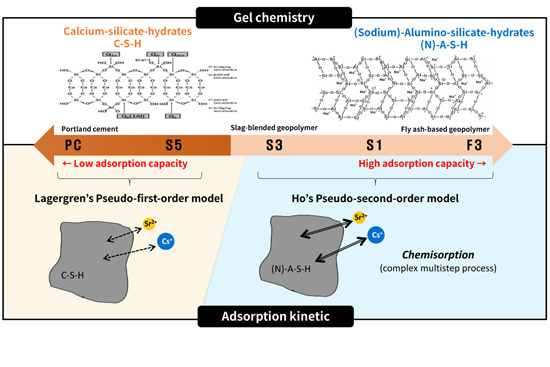Cesium and Strontium Retentions Governed by Aluminosilicate Gel in Alkali-Activated Cements
Abstract
:1. Introduction
2. Materials and Methods
2.1. Materials and Sample Preparation
2.2. Test Methods
3. Results
3.1. Precipitation and Crystalline Formation
3.2. Adsorption Kinetics
3.3. Characteristics of Gel in Alkali-Activated Cements
4. Discussion
5. Conclusions
- (1)
- The incorporation of cesium in all binders did not result in the formation of a new crystal or change in the crystalline phases, whereas that of strontium resulted in precipitation of strontium hydroxide and strontium carbonate. The higher frequency of strontium precipitation in alkali-activated cements is attributed to the use of an alkali-activating solution with a high pH.
- (2)
- Batch adsorption test results showed that the cesium and strontium adsorption of the binders were in the following order: PC < S5 < S3 < S1 < S0. The adsorption kinetics of PC and S5, with relatively low adsorption capacities for cesium and strontium, were compatible with Lagergren’s pseudo-first-order model, while those of S3, S1 and S0, with relatively higher adsorption capacities, were compatible with Ho’s pseudo-second-order model. These results indicate that the cesium and strontium adsorption kinetics of S3, S1 and S0 were affected by the complex multistep chemisorption process.
- (3)
- The zeta potential and BET surface area values of binders showed a high correlation with the adsorption capacities for cesium and strontium. Alkali-activated fly ash had a highly negatively charged surface as well as the highest surface area and mesopore volume, indicating that these characteristics of aluminosilicate gel facilitated the more effective immobilization of cesium and strontium through electrostatic interactions and the chemisorption mechanism in comparison with the calcium silicate hydrate gel.
Acknowledgments
Author Contributions
Conflicts of Interest
References
- Shi, C.; Spence, R. Designing of cement-based formula for solidification/stabilization of hazardous, radioactive, and mixed wastes. Crit. Rev. Environ. Sci. Technol. 2004, 34, 391–417. [Google Scholar] [CrossRef]
- Atkins, M.; Glasser, F.P. Application of Portland cement-based materials to radioactive waste immobilization. Waste Manag. 1992, 12, 105–131. [Google Scholar] [CrossRef]
- Ojovan, M.I. Handbook of Advanced Radioactive Waste Conditioning Technologies; Woodhead Publishing Limited: Sawston, UK, 2011. [Google Scholar]
- Bart, F.; Cau-dit-Coumes, C.; Frizon, F.; Lorente, S. Cement-Based Materials for Nuclear Waste Storage; Springer: Berlin, Germany, 2013. [Google Scholar]
- Mehta, P.K.; Monteiro, P.J.M. Concrete: Microstructure, Properties, and Materials, 3rd ed.; McGraw-Hill Professional: New York, NY, USA, 2005. [Google Scholar]
- Haworth, A.; Sharland, S.M.; Tweed, C.J. Modelling of the degradation of cement in a nuclear waste repository. MRS Proc. 1988, 127, 447–454. [Google Scholar] [CrossRef]
- Adenot, F.; Buil, M. Modelling of the corrosion of the cement paste by deionized water. Cem. Concr. Res. 1998, 22, 489–496. [Google Scholar] [CrossRef]
- Goñi, S.; Guerrero, A.; Lorenzo, M.P. Efficiency of fly ash belite cement and zeolite matrices for immobilizing cesium. J. Hazard. Mater. 2006, 137, 1608–1617. [Google Scholar] [CrossRef] [PubMed]
- Rahman, R.O.A.; Zaki, A.A.; El-Kamash, A.M. Modeling the long-term leaching behavior of 137Cs, 60Co, and 152,154Eu radionuclides from cement–clay matrices. J. Hazard. Mater. 2007, 145, 372–380. [Google Scholar] [PubMed]
- Lyon, R.E.; Balaguru, P.N.; Foden, A.; Sorathia, U.; Davidovits, J.; Davidovics, M. Fire-resistant aluminosilicate composites. Fire Mater. 1997, 21, 67–73. [Google Scholar] [CrossRef]
- Williamson, T.; Juenger, M.C.G. The role of activating solution concentration on alkali–silica reaction in alkali-activated fly ash concrete. Cem. Concr. Res. 2016, 83, 124–130. [Google Scholar] [CrossRef]
- Park, S.M.; Jang, J.G.; Chae, S.; Lee, H.K. An NMR spectroscopic investigation of aluminosilicate gel in alkali-activated fly ash in a CO2-rich environment. Materials 2016, 9, 308. [Google Scholar] [CrossRef]
- Duxson, P.; Lukey, G.C.; van Deventer, J.S.J. Thermal conductivity of metakaolin geopolymers used as a first approximation for determining gel interconnectivity. Ind. Eng. Chem. Res. 2006, 45, 7781–7788. [Google Scholar] [CrossRef]
- Chindaprasirt, P.; Chareerat, T.; Sirivivatnanon, V. Workability and strength of coarse high calcium fly ash geopolymer. Cem. Concr. Compos. 2007, 29, 224–229. [Google Scholar] [CrossRef]
- Li, X.; Wang, Z.; Jiao, Z. Influence of curing on the strength development of calcium-containing geopolymer mortar. Materials 2013, 6, 5069–5076. [Google Scholar] [CrossRef]
- Lee, N.K.; Jang, J.G.; Lee, H.K. Shrinkage characteristics of alkali-activated fly ash/slag paste and mortar at early ages. Cem. Concr. Compos. 2014, 53, 239–248. [Google Scholar] [CrossRef]
- Bakharev, T. Thermal behaviour of geopolymers prepared using class F fly ash and elevated temperature curing. Cem. Concr. Res. 2006, 36, 1134–1147. [Google Scholar] [CrossRef]
- Sakkas, K.; Sofianos, A.; Nomikos, P.; Panias, D. Behaviour of passive fire protection K-geopolymer under successive severe fire incidents. Materials 2015, 8, 6096–6104. [Google Scholar] [CrossRef]
- Lee, N.K.; Khalid, H.R.; Lee, H.K. Adsorption characteristics of cesium onto mesoporous geopolymers containing nano-crystalline zeolites. Microporous Mesoporous Mater. 2017, 242, 238–244. [Google Scholar] [CrossRef]
- Davidovits, J.; Comrie, D.C. Long term durability of hazardous toxic and nuclear waste disposals. In Proceedings of the Geopolymer’88—First European Conference on Soft Mineralurgy, Compeigne, France, 1–3 June 1988; pp. 125–134. [Google Scholar]
- Khalil, M.Y.; Merz, E. Immobilization of intermediate-level wastes in geopolymers. J. Nucl. Mater. 1994, 211, 141–148. [Google Scholar] [CrossRef]
- Fernández-Jiménez, A.; Macphee, D.E.; Lachowski, E.E.; Palomo, A. Immobilization of cesium in alkaline activated fly ash matrix. J. Nucl. Mater. 2005, 346, 185–193. [Google Scholar] [CrossRef]
- Bankowski, P.; Zou, L.; Hodges, R. Reduction of metal leaching in brown coal fly ash using geopolymers. J. Hazard. Mater. 2004, 114, 59–67. [Google Scholar] [CrossRef] [PubMed]
- Jang, J.G.; Park, S.M.; Lee, H.K. Physical barrier effect of geopolymeric waste form on diffusivity of cesium and strontium. J. Hazard. Mater. 2016, 318, 339–346. [Google Scholar] [CrossRef] [PubMed]
- Shi, C.; Fernández-Jiménez, A. Stabilization/solidification of hazardous and radioactive wastes with alkali-activated cements. J. Hazard. Mater. 2006, 137, 1656–1663. [Google Scholar] [CrossRef] [PubMed]
- Jang, J.G.; Lee, N.K.; Lee, H.K. Fresh and hardened properties of alkali-activated fly ash/slag pastes with superplasticizers. Constr. Build. Mater. 2014, 50, 169–176. [Google Scholar] [CrossRef]
- Jang, J.G.; Lee, H.K. Effect of fly ash characteristics on delayed high-strength development of geopolymers. Constr. Build. Mater. 2016, 102, 260–269. [Google Scholar] [CrossRef]
- El-Kamash, A.M. Evaluation of zeolite A for the sorptive removal of Cs+ and Sr2+ ions from aqueous solutions using batch and fixed bed column operations. J. Hazard. Mater. 2008, 151, 432–445. [Google Scholar] [CrossRef] [PubMed]
- Li, K.; Pang, X. Sorption of radionuclides by cement-based barrier materials. Cem. Concr. Res. 2014, 65, 52–57. [Google Scholar] [CrossRef]
- Suryavanshi, A.K.; Scantlebury, J.D.; Lyon, S.B. Mechanism of Friedel’s salt formation in cements rich in tri-calcium aluminate. Cem. Concr. Res. 1996, 26, 717–727. [Google Scholar] [CrossRef]
- Matschei, T.; Lothenbach, B.; Glasser, F.P. The AFm phase in Portland cement. Cem. Concr. Res. 2007, 37, 118–130. [Google Scholar] [CrossRef]
- Lagergren, S. Zur Theorie Der Sogenannten Absorption Gelöster Stoffe; PA Norstedt & Söner: Stockholm, Sweden, 1898. [Google Scholar]
- Ho, Y.S.; McKay, G. Pseudo-second order model for sorption processes. Process Biochem. 1999, 34, 451–465. [Google Scholar] [CrossRef]
- Ho, Y.S.; Ng, J.C.Y.; McKay, G. Removal of lead (II) from effluents by sorption on peat using second-order kinetics. Sep. Sci. Technol. 2001, 36, 241–261. [Google Scholar] [CrossRef]
- Mimura, H.; Kanno, T. Distribution and fixation of cesium and strontium in zeolite A and chabazite. J. Nucl. Sci. Technol. 1985, 22, 284–291. [Google Scholar] [CrossRef]
- Pointeau, I.; Marmier, N.; Fromage, F.; Fedoroff, M.; Giffaut, E. Cesium and lead uptake by CSH phases of hydrated cement. MRS Proc. 2001, 663, 105–113. [Google Scholar] [CrossRef]
- Flury, M.; Czigàny, S.; Chen, G.; Harsh, J.B. Cesium migration in saturated silica sand and Hanford sediments as impacted by ionic strength. J. Contam. Hydrol. 2004, 71, 111–126. [Google Scholar] [CrossRef] [PubMed]
- Cronstrand, P. Assessment of Uncertainty Intervals Sorption Intervals; SKB Report R-05-75; Swedish Nuclear Fuel and Waste Management Co.: Stockholm, Sweden, 2005. [Google Scholar]
- Ochs, M.; Pointeau, I.; Giffaut, E. Caesium sorption by hydrated cement as a function of degradation state: Experiments and modelling. Waste Manag. 2006, 26, 725–732. [Google Scholar] [CrossRef] [PubMed]
- Osmanlioglu, A.E. Treatment of radioactive liquid waste by sorption on natural zeolite in Turkey. J. Hazard. Mater. 2006, 137, 332–335. [Google Scholar] [CrossRef] [PubMed]
- Tits, T.; Wieland, E.; Müller, C.J.; Landesman, C.; Bradbury, M.H. Strontium binding by calcium silicate hydrates. J. Colloid Interface Sci. 2006, 300, 78–87. [Google Scholar] [CrossRef] [PubMed]
- Wieland, E.; Tits, J.; Kunz, D.; Dähn, R. Strontium uptake by cementitious materials. Environ. Sci. Technol. 2008, 42, 403–409. [Google Scholar] [CrossRef] [PubMed]
- Li, Y.F.; Tian, S.H.; Qian, T.W. Transport and retention of strontium in surface-modified quartz sand with different wettability. J. Radioanal. Nucl. Chem. 2011, 289, 337–343. [Google Scholar] [CrossRef]
- Merceille, A.; Weinzaepfel, E.; Barré, Y.; Grandjean, A. The sorption behaviour of synthetic sodium nonatitanate and zeolite A for removing radioactive strontium from aqueous wastes. Sep. Purif. Technol. 2012, 96, 81–88. [Google Scholar] [CrossRef]
- Brough, A.R.; Atkinson, A. Sodium silicate-based, alkali-activated slag mortars: Part I. Strength, hydration and microstructure. Cem. Concr. Res. 2002, 32, 865–879. [Google Scholar] [CrossRef]
- Lee, N.K.; Lee, H.K. Reactivity and reaction products of alkali-activated, fly ash/slag paste. Constr. Build. Mater. 2015, 81, 303–312. [Google Scholar] [CrossRef]
- Lau, A.; McLaughlin, A.; McLaughlin, S. The adsorption of divalent cations to phosphatidylglycerol bilayer membranes. BBA Biomembr. 1981, 645, 279–292. [Google Scholar] [CrossRef]
- Lin, S.-H.; Juang, R.-S. Heavy metal removal from water by sorption using surfactant-modified montmorillonite. J. Hazard. Mater. 2002, 92, 315–326. [Google Scholar] [CrossRef]
- Long, H.; Wu, P.; Zhu, N. Evaluation of Cs+ removal from aqueous solution by adsorption on ethylamine-modified montmorillonite. Chem. Eng. J. 2013, 225, 237–244. [Google Scholar] [CrossRef]
- Ho, Y.S. Review of second-order models for adsorption systems. J. Hazard. Mater. 2006, 136, 681–689. [Google Scholar] [CrossRef] [PubMed]
- Bell, J.L.; Sarin, P.; Provis, J.L.; Haggerty, R.P.; Driemeyer, P.E.; Chupas, P.J.; van Deventer, J.S.J.; Kriven, W.M. Atomic structure of a cesium aluminosilicate geopolymer: A pair distribution function study. Chem. Mater. 2008, 20, 4768–4776. [Google Scholar] [CrossRef]


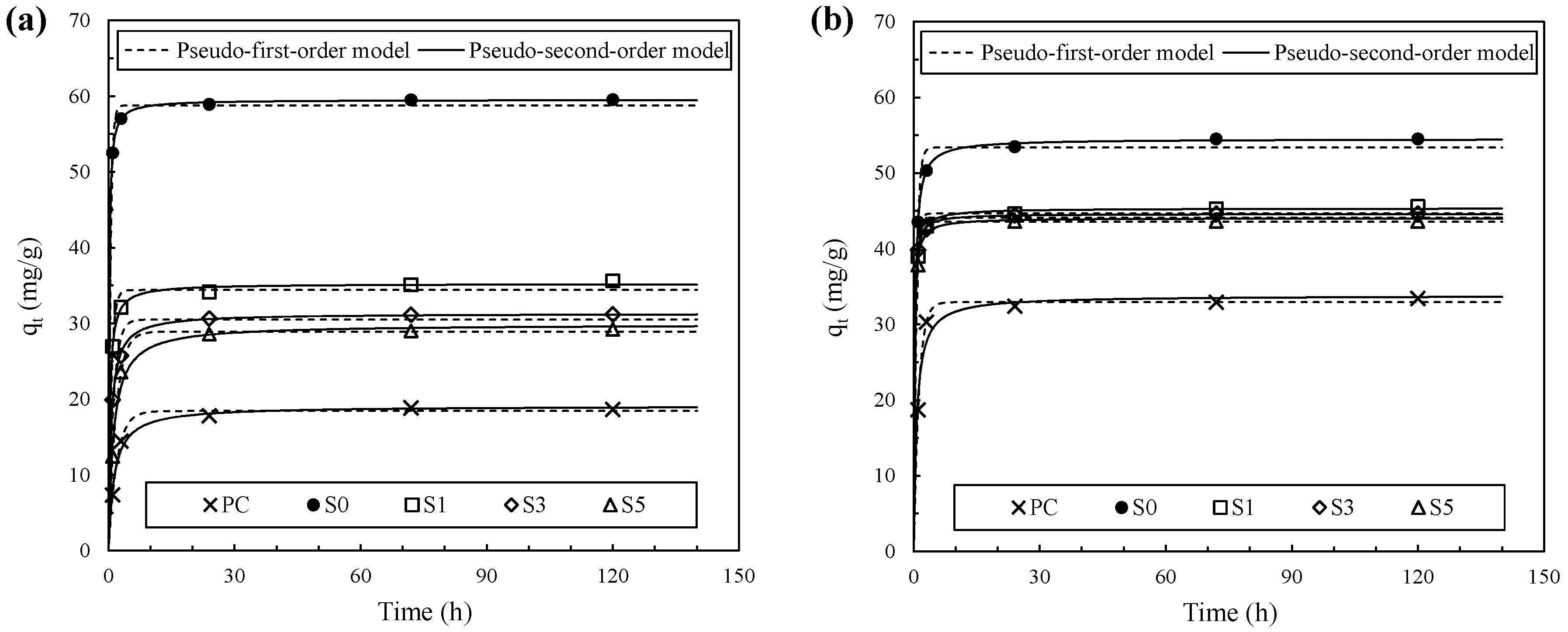
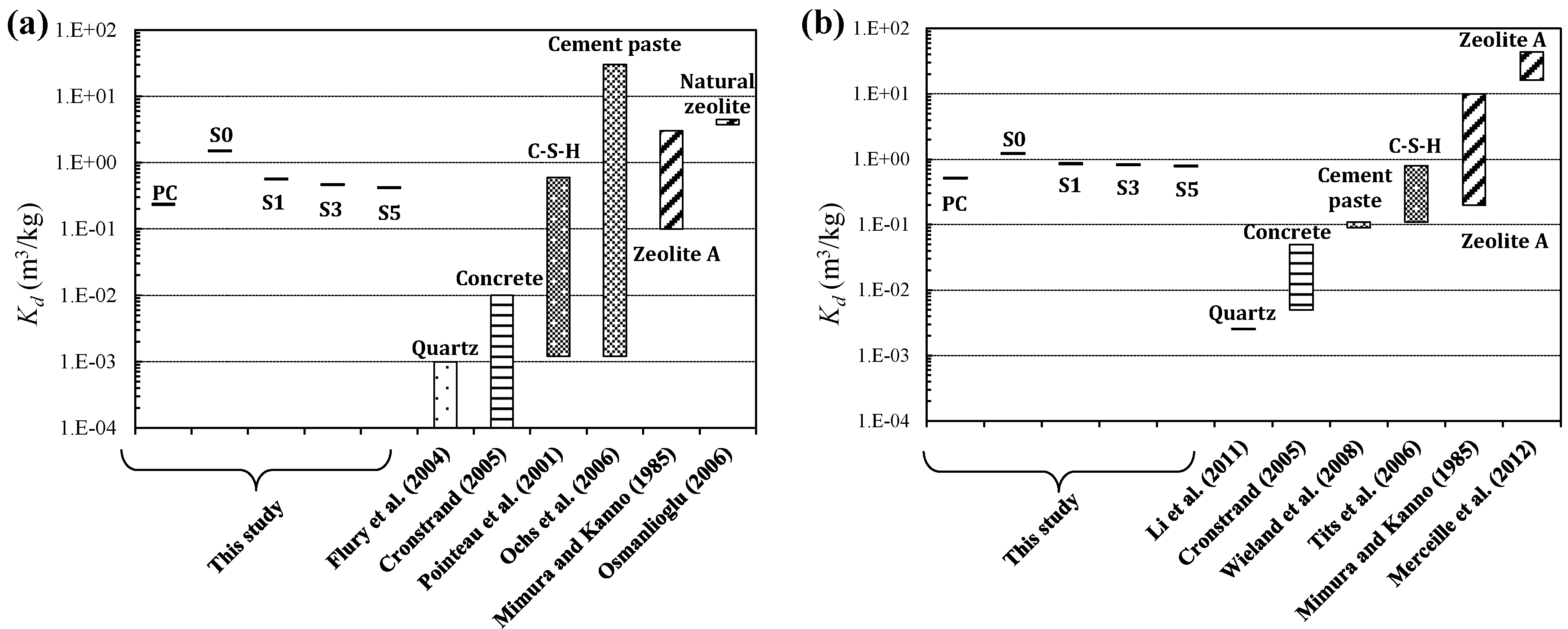
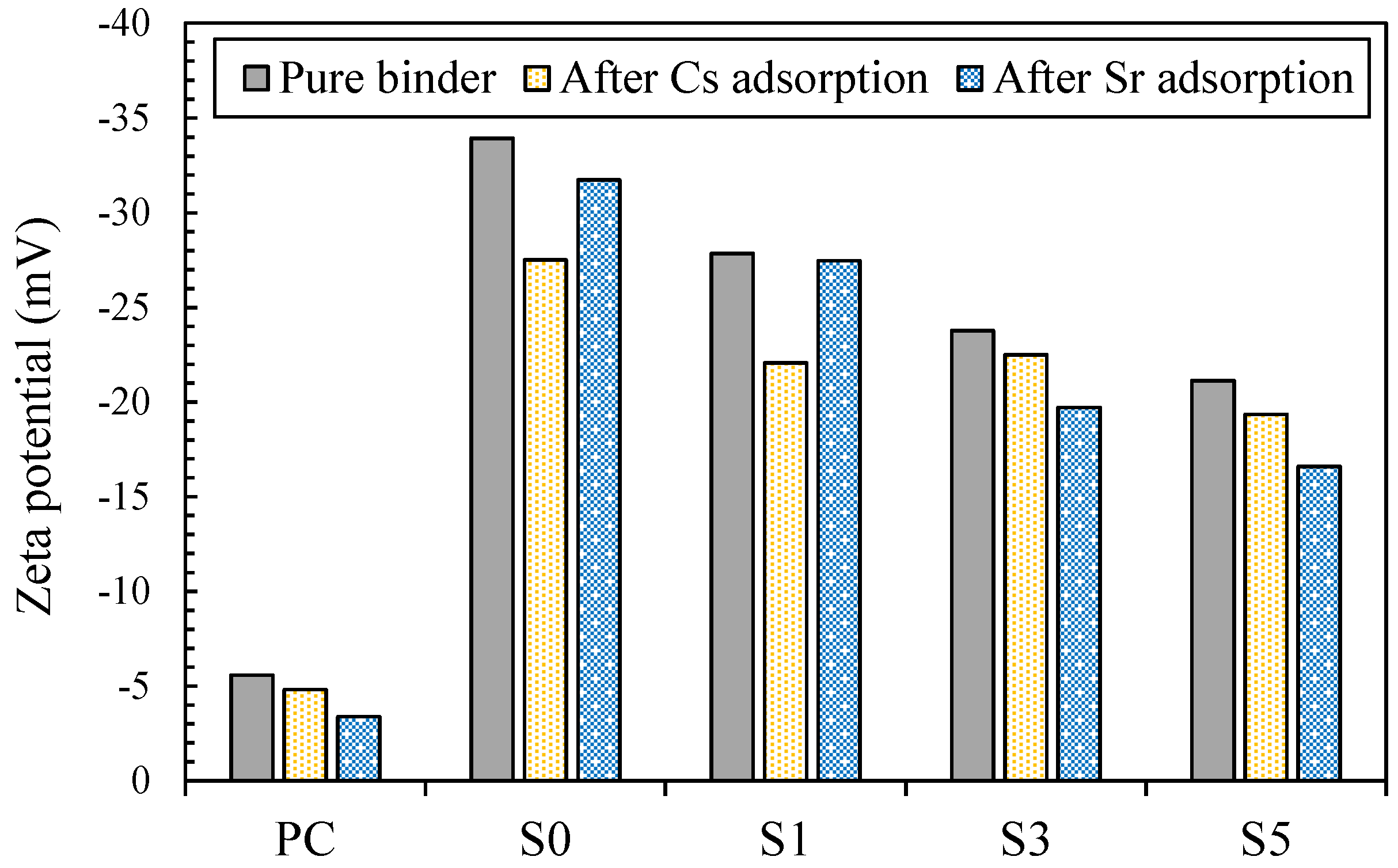
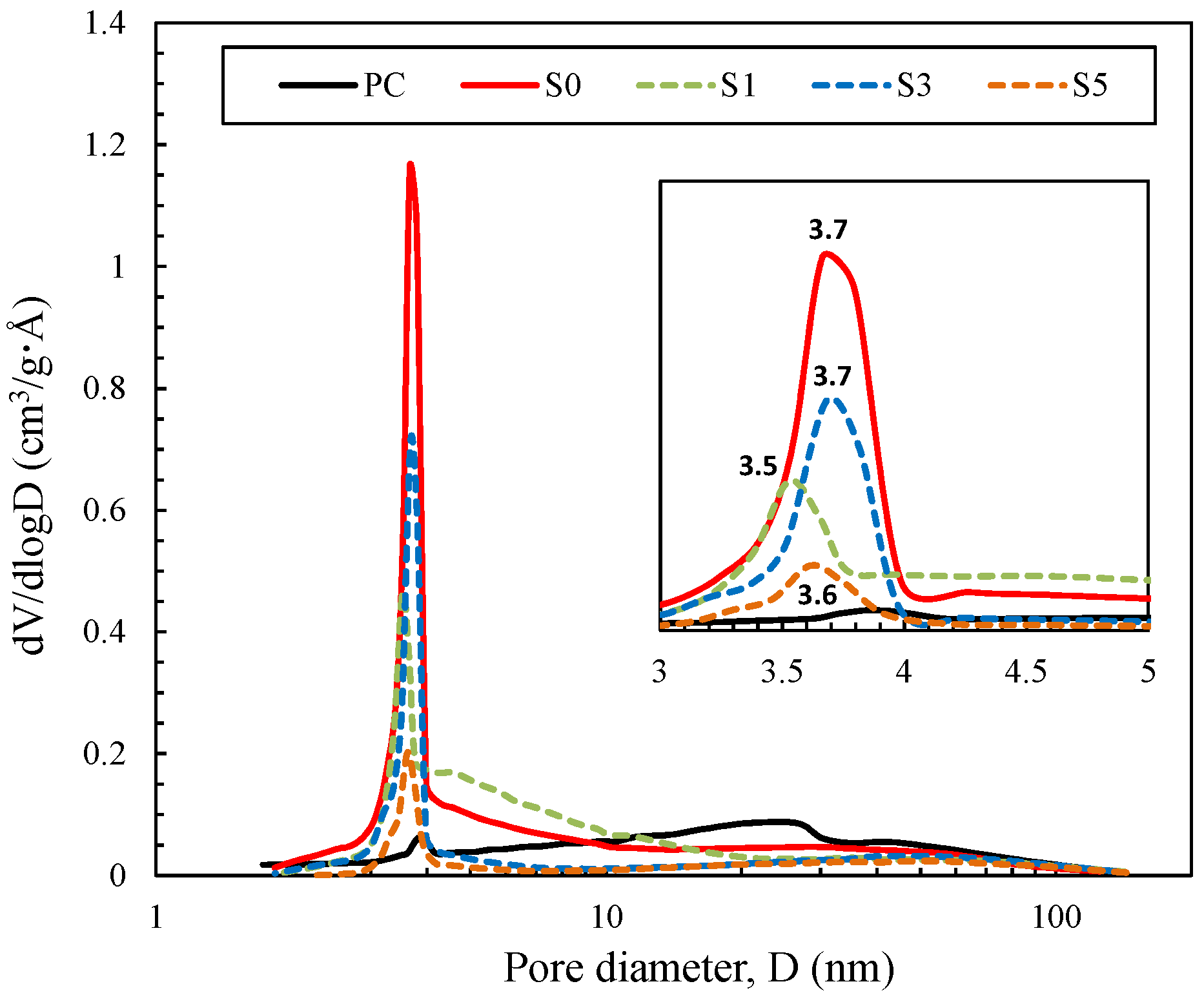
| (wt %) | Fly Ash | Slag | Portland Cement |
|---|---|---|---|
| CaO | 5.3 | 47.7 | 62.5 |
| SiO2 | 51.5 | 32.4 | 21.0 |
| Al2O3 | 22.0 | 11.5 | 5.9 |
| Fe2O3 | 10.8 | 0.6 | 3.2 |
| MgO | 2.0 | 3.0 | 2.8 |
| K2O | 1.2 | 0.5 | 0.9 |
| TiO2 | 1.6 | 0.5 | - |
| SO3 | 0.7 | 2.7 | 2.1 |
| Sample Code | Mix Design (Relative Weight Proportion) | Initial Curing (for 24 h) |
|---|---|---|
| PC | Portland cement (1.0) + Water (0.5) | 20 °C |
| S0 | Fly ash (1.0) + 9 M NaOH (0.25) + Sodium silicate (0.25) | 60 °C |
| S1 | Fly ash (0.9) + Slag (0.1) + 4 M NaOH (0.33) + Sodium silicate (0.17) | 20 °C |
| S3 | Fly ash (0.7) + Slag (0.3) + 4 M NaOH (0.33) + Sodium silicate (0.17) | 20 °C |
| S5 | Fly ash (0.5) + Slag (0.3) + 4 M NaOH (0.33) + Sodium silicate (0.17) | 20 °C |
| Binder | Experimental | Pseudo-First-Order Model | Pseudo-Second-Order Model | ||||
|---|---|---|---|---|---|---|---|
| (mg/g) | (h−1) | (mg/g) | R2 | (g mg−1 h−1) | (mg/g) | R2 | |
| PC | 18.65 | 0.510 | 18.44 | 0.994 | 0.040 | 19.09 | 0.976 |
| S0 | 59.57 | 2.230 | 58.80 | 0.888 | 0.127 | 59.52 | 0.997 |
| S1 | 35.61 | 1.492 | 34.41 | 0.887 | 0.093 | 35.23 | 0.988 |
| S3 | 31.21 | 0.861 | 30.50 | 0.911 | 0.054 | 31.32 | 0.998 |
| S5 | 29.22 | 0.563 | 28.94 | 0.999 | 0.029 | 29.87 | 0.970 |
| Binder | Experimental | Pseudo-First-Order Model | Pseudo-Second-Order Model | ||||
|---|---|---|---|---|---|---|---|
| (mg/g) | (h−1) | (mg/g) | R2 | (g mg−1 h−1) | (mg/g) | R2 | |
| PC | 33.44 | 0.843 | 32.92 | 0.996 | 0.044 | 33.80 | 0.935 |
| S0 | 54.52 | 1.662 | 53.38 | 0.887 | 0.073 | 54.49 | 0.997 |
| S1 | 45.59 | 2.048 | 44.67 | 0.872 | 0.135 | 45.33 | 0.991 |
| S3 | 44.65 | 2.119 | 44.10 | 0.836 | 0.183 | 44.61 | 0.994 |
| S5 | 43.64 | 2.030 | 43.56 | 0.998 | 0.154 | 44.03 | 0.914 |
| Binder | PC | S0 | S1 | S3 | S5 |
|---|---|---|---|---|---|
| BET surface area (m2/g) | 36.2 | 77.6 | 55.6 | 37.8 | 12.72 |
| BJH cumulative volume of pores (cm3/g) | 0.089 | 0.138 | 0.116 | 0.071 | 0.037 |
| BJH average pore diameter (nm) | 9.8 | 5.2 | 5.9 | 5.4 | 8.0 |
© 2017 by the authors. Licensee MDPI, Basel, Switzerland. This article is an open access article distributed under the terms and conditions of the Creative Commons Attribution (CC BY) license (http://creativecommons.org/licenses/by/4.0/).
Share and Cite
Jang, J.G.; Park, S.M.; Lee, H.K. Cesium and Strontium Retentions Governed by Aluminosilicate Gel in Alkali-Activated Cements. Materials 2017, 10, 447. https://doi.org/10.3390/ma10040447
Jang JG, Park SM, Lee HK. Cesium and Strontium Retentions Governed by Aluminosilicate Gel in Alkali-Activated Cements. Materials. 2017; 10(4):447. https://doi.org/10.3390/ma10040447
Chicago/Turabian StyleJang, Jeong Gook, Sol Moi Park, and Haeng Ki Lee. 2017. "Cesium and Strontium Retentions Governed by Aluminosilicate Gel in Alkali-Activated Cements" Materials 10, no. 4: 447. https://doi.org/10.3390/ma10040447





